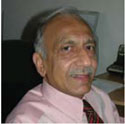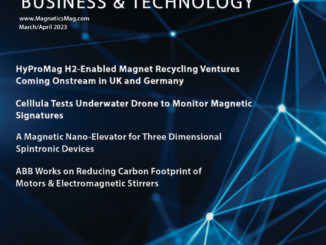By Jeremy Good, Managing Director | Cryogenic Ltd.
Liquid helium has been a cornerstone of magnetics research for more than a century. The discovery of superconductivity in 1911 was only made possible by the first successful liquefaction of the element, a transition requiring temperatures below 4K. Ever since then, liquid helium has been used to cool materials to close to absolute zero, a temperature range where exciting electronic and magnetic properties can be observed.
 Despite being the second most abundant element in the Universe, however, helium is in short supply on Earth, an issue of increasingly pressing concern to magnetics researchers the world over. Unless reliable alternatives can be developed and implemented in the near future, a global helium shortfall could kick in by 2016 with dramatic consequences for price and availability.
Despite being the second most abundant element in the Universe, however, helium is in short supply on Earth, an issue of increasingly pressing concern to magnetics researchers the world over. Unless reliable alternatives can be developed and implemented in the near future, a global helium shortfall could kick in by 2016 with dramatic consequences for price and availability.
Why Helium Matters
At very cold temperatures the optical, thermal, electric and magnetic properties of all materials undergo significant changes. The logarithmic nature of the temperature scale means properties that cannot be studied at 4K (the boiling point of liquid helium) may reveal themselves at 0.3K, a temperature which can be achieved by using the rarer isotope Helium-3 (He-3). Similarly, some properties not manifest at 0.3K can be studied at much lower temperatures of say 10 millikelvin.
Any experimental system built to examine these properties requires a stable temperature of 4K and traditionally this has involved using liquid helium. Lower temperatures are then achieved using a Dilution Refrigerator in which He-3 is continuously dissolved in liquid He-4. Even lower temperatures well below 1 millikelvin can also be achieved with the aid of a magnetic refrigerator.
An important phenomenon observable at these low temperatures is the generation of high magnetic fields. Up until the 1960s magnetic fields could only be created with iron electromagnets or very expensive copper solenoids. Fields were generally restricted to 2 Tesla across pole pieces a few centimeters apart. The discovery of high-field superconductors paved the way for the construction of superconducting magnets, and today fields of 20 Tesla can be created over spaces spanning several meters.
Magnetics researchers the world over have come to rely on liquid helium for their experiments. Raphaël Hermann, Group leader at the Jülich Centre for Neutron Science, Germany, and Invited Professor at the University of Liège, Belgium, for many years used such a ‘wet’ cryogenic system to determine the magnetic properties of iron and cobalt nanoparticles. When provided with an alternative system that relied on mechanical cooling instead, he was able to save thousands of dollars a month that would otherwise have been wasted through the unavoidable boiling of liquid helium.
Other exciting practical magnetics applications arising from low temperature research include use in high-energy particle accelerators, improved wind turbine and increased memory storage on hard disks.
A Diminishing Resource
Helium is produced as a significant byproduct of natural gas extraction, and is used in a number of industrial applications as well as in scientific instruments and superconducting magnets.
Once helium is released into the air it is lost forever, and few natural gas wells are in a position to produce more helium in an economically viable way. So we are reliant on our limited existing supplies.
The Federal Helium Reserve in Amarillo, which provides 42 percent of America’s helium and 35 percent of the world’s, is a major source of the gas. The US House of Representatives’ decision in September to delay the closing of the reserve is therefore good news for the community. But it is a reserve that is not being replenished and is projected to last no more than another 25 years. And as supply dwindles, the price will rise rapidly.
In addition to decreasing supplies and rising prices, liquefaction of helium also requires a great deal of energy. In the UK a liter of liquid helium costs more than $10 to produce, but in Japan, a world leader in low temperature research, this rises to more than $30.
For regions with emerging research bases, such as the Middle East, Nigeria and Brazil, liquid helium is an even more expensive commodity. As they do not have the facilities to produce liquid helium they must import it, an operation that takes time and money and often leaves it boiling away in customs for weeks.
The challenges do not end there. Superconducting magnets, which use liquid helium need to be regularly topped up, a complicated process during which the magnets run the risk of quenching, a process in which the liquid helium surrounding the magnet rapidly boils off. Systems using liquid helium require large areas with suitable ventilation facilities and a technician on hand who is trained in cryogenics.
So, while the days of liquid helium aren’t quite over, it is clearly becoming less and less attractive.
Where Next?
One attempted solution has been to try to recover the gas as it boils off, but this can be costly and, except in the most advanced systems such as the LHC at CERN, users struggle to capture and then reliquify 100 percent of the gas.
Having spent a lifetime in cryogenics, I’m convinced the future lies in ‘cryogen-free’ or ‘dry’ mechanical systems.
Unlike existing systems, cryogen-free technology uses mechanical refrigerators consisting of a compressor and cold head package. These cool to cryogenic temperatures using only electrical power. They are heat engines and use the Gifford-McMahon (GM) or Pulse Tube (PT) thermodynamic cycles to provide cooling, both of which involve repeated compression and expansion of a small quantity of helium gas to generate low temperatures.
They have slightly different thermodynamic cycles but in both cases the gas is supplied by an external conventional compressor, and a motor-driven set of valves forces repeated expansion of the gas causing a decrease in both pressure and temperature. The GM machine has moving cold pistons through which the gas passes. The PT machine relies on a gas pulse resonance to control and set the flow through regenerating heat exchangers. It also has no cold moving parts, which many people consider to be an advantage. Finally, the gas returns to the compressor, completing the closed loop circulation of gas through the cold head. The level of helium required is extremely small and no gas is lost in the process.
Both GM and PT coolers can reach temperatures as low as 2.6K, and have a cooling of 1 to 2 watts at 4K. They can run for more than a year without attention, making the use of low temperatures very simple for technicians without specialist knowledge.
The upshot is that low temperatures can be created anywhere with just an electrical power supply.
The Future of Low Temperature
Purchasing large amounts of liquid helium is becoming less and less viable. In recent years major research laboratories have had to temporarily shut down multimillion-pound facilities as a result of these shortages and the problem will only get worse. According to predictions released by Japan’s Ministry of Economy, Trade and Industry in April, the global helium supply will fall short of demand by 22 percent in 2020.
The scarcity of helium as a natural resource has also made its availability particularly sensitive to the global political situation. Access to the large Russian reservoirs has been limited in the wake of the recent situation in the Crimea, an issue of pressing concern for laboratories in Europe as well as in China and Japan.
Researchers have faced and overcome problems of this sort before. Cryogenic research ground to a halt in the country of Georgia once the supply of liquid helium from Moscow dried up following independence in 1991. For the next 17 years Georgia was without liquid helium but the low temperature expertise and infrastructure was not lost.
Professor Alexander Shengelaya, Director of the Institute of Condensed Matter Physics and Advanced Materials at Tbilisi State University in Georgia, made use of a five Tesla cryogen-free vibrating sample magnetometer (VSM) to continue his research on colossal magetoresistance materials. His work has since been published in the Journal of Superconductivity and Novel Magnetism and reported at two international conferences, allowing him to continue Georgia’s long tradition of low temperature physics research.
Alternatives such as these, which do not rely on a regular supply of helium or an expensive liquefaction process, are essential if we are to continue and expand magnetics research over the coming decades. Researchers as far afield as India, Denmark and the US have already made the move towards cryogen-free equipment, and more facilities should be encouraged to follow their lead. Not only will it help address the rising cost and depleting supplies of helium, but it will make low temperature research viable in emerging research areas which can neither access nor afford liquid helium.
 About the Author
About the Author
Dr. Jeremy Good, managing director of Cryogenic Ltd, worked on research into high field superconductivity at Oxford receiving a D.Phil. He founded Cryogenic Consultants Ltd (CCL) and was the managing director for 21 years. He has filed over a dozen patents for inventions relating to magnet construction and applications. For more information visit www.cryogenic.co.uk.



